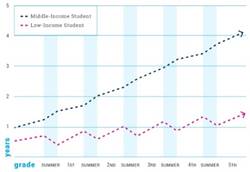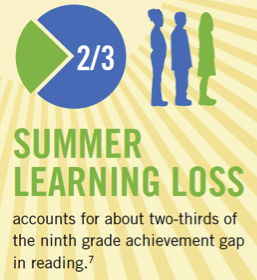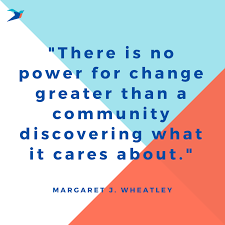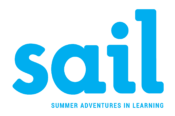For School Districts
Summer Learning Loss is Real
Children regress when they don’t practice their academic skills over the summer. This is known as  summer learning loss, or the summer slide. Children from low-income families lose two-three months of grade equivalency in both math and reading every summer, year after year. When the students return to school in the fall, teachers lose weeks of valuable time bringing the class back on trajectory. This shortens the school year, and makes the gap permanent; it grows over time.
summer learning loss, or the summer slide. Children from low-income families lose two-three months of grade equivalency in both math and reading every summer, year after year. When the students return to school in the fall, teachers lose weeks of valuable time bringing the class back on trajectory. This shortens the school year, and makes the gap permanent; it grows over time.
Summer Learning Loss Lasts a Lifetime
 A study by Johns Hopkins University measured the gap in reading as three years by the end of the ninth grade. They found that 2/3 of the gap was attributable to summer learning loss. Further, they found that summer learning loss was the primary driver of later problems; failure to graduate, to attend college, and to successfully enter the workforce. To see the Research Brief, click here.
A study by Johns Hopkins University measured the gap in reading as three years by the end of the ninth grade. They found that 2/3 of the gap was attributable to summer learning loss. Further, they found that summer learning loss was the primary driver of later problems; failure to graduate, to attend college, and to successfully enter the workforce. To see the Research Brief, click here.
Children From Under-served Communities Face Many Summer Challenges
Children from under-served communities face other challenges over the summer as well; many do not eat well, do not exercise, and lack a safe environment that is free from harmful influences. Parents consistently cite summer as the most difficult time to ensure that their children have productive things to do.

Effective summer learning nurtures the whole child; effective programs are a hybrid of school and summer camp. Programs must be built on a foundation of rigorous academics, yet feel like camp to the children. To do this well requires skills and expertise seldom found in any single person or organization; it takes a community!
 Community-based summer learning brings together the people who care about the children of the community (churches, schools, youth organizations, non-profits, government agencies, civic leaders, and so on) to combine their resources (financial, intellectual and social) for summer programming of high quality that would be difficult if not impossible for any of them to offer alone.
Community-based summer learning brings together the people who care about the children of the community (churches, schools, youth organizations, non-profits, government agencies, civic leaders, and so on) to combine their resources (financial, intellectual and social) for summer programming of high quality that would be difficult if not impossible for any of them to offer alone.
With SAIL, each community has the flexibility to develop programs that best meet its needs. SAIL defines Markers of Quality and provides support resources to assure that target outcomes are achieved.
Alabama must marshal the resources, skills, and passion of our communities to realize the power of “Every Child, Every Chance, Every Day!”
Alabama and National Education Policy Promote Community-Based Summer Learning
- ♦ The Alabama Literacy Act provides that summer reading camps “may be held in conjunction with existing summer programs in the school district or in partnership with community-based summer programs, designated as effective……”
- ♦ Gov. Ivey’s Alabama Campaign for Grade-Level Reading recommends, “Leverage community-based before- and after-school and summer-learning programs to offer additional learning opportunities for struggling readers.”
- ♦ The Alabama Committee on Grade-Level Reading (established under the Literacy Act) agrees, “Community partners, in tandem with schools and families, can maximize resources to promote health, well-being, and learning for all students.”
- ♦ Gov. Ivey (in her 2021 State-of-the-State Address) urges, “Catching our students up won’t happen overnight or during the traditional school hours. As such, I am urging all our schools to partner with community organizations in your local area; this will be more important than ever before to be innovative and create new opportunities for summer and after school programs……”
- ♦ The A+ Education Partnership reports, “The research is clear. Children that regularly attend high-quality out-of-school-time programs have improved academic and career outcomes, school attendance, and mental health.”
- ♦ The Alabama Business Education Alliance states, “All students should be provided the instruction they need during school, after school, and over the summer, working with community partners.”
- ♦ Alabama’s Education Trust Fund now provides significant funding for community-based summer and afterschool programs.
Policy and funding are converged; now is the time to act!
Suggestion 1: Develop a three-year strategy
- ♦ The initial learning curve for summer programs is about three years
- ♦ It takes time to align a community (i.e., build effective working relationships and trust)
- ♦ Three years will allow the time to build a self-sustaining, community-based initiative with several proven programs
Suggestion 2: Organize your community thoughtfully
- ♦ Community boundaries ≠ school district boundaries; define your community creatively to maximize resources. Think about a county (or two or three).
- ♦ Students are not bound by school zones for summer learning. They may choose a program based on membership in a church or youth organization. Families sometimes spend summers in a different locale for work or childcare. All children must be served, including those who do not attend public schools.
- ♦ Your leader is crucial; choose wisely
- → Your leader has a passion for children, persistence, and people skills
- → Your leader is probably with a community or civic organization and has experience with community-wide projects
- → Your leader must be able to devote time/effort, especially early on
Suggestion 3: Build on what is already in place
- ♦ Reach out to summer programs in your community (and elsewhere). To find SAIL programs in Alabama, click here.
- ♦ Assess program strengths/gaps
- → Many summer programs have academic components, but not all are rigorous
- → SAIL resources can help; several are listed below.
- ♦ Collaborate to capitalize on strengths, close gaps and replicate success
Suggestion 4: Plan together; plan early; repeat annually
- ♦ Failure to plan together causes competition for students and staff. We lack the resources to serve all students who need summer learning, so we must collaborate for maximum impact.
- ♦ The annual planning cycle for summer should:
- → Start in the fall
- → Finalize key decisions in January/February, so that
- → Community partners can complete their preparations and recruit their families from March-May
Suggestion 5: Share and share alike
- ♦ School systems have assets that community partners often lack: Public funding, classroom space, computers, curriculum, assessment tools, teachers, admin support, transportation
- ♦ Community partners have assets that schools often lack: Non-traditional funding and teachers, recreational facilities, members, social network
Together, we have the resources for success!
- ♦ SAIL has compiled a list of the markers of quality for summer learning. These are based in the best practices published by the National Summer Learning Association and refined by lessons learned in Alabama (link).
- ♦ The National Summer Learning Association Knowledge Center has many resources (link).
- ♦ The Wallace Foundation Knowledge Center offers a wealth of resources (link).
